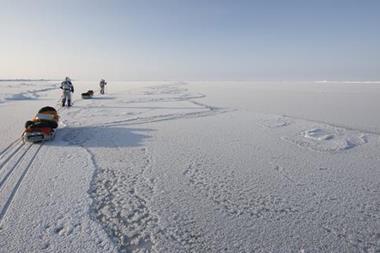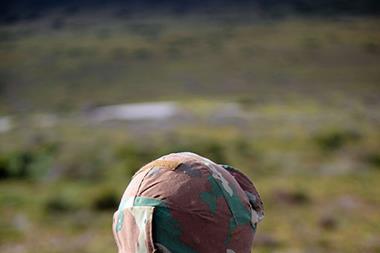Marine piracy, resource wars and terrorism. This Royal Navy and Special Forces veteran gives us his view on the risks coming out of the sea
The scramble for access to the treasurers of the sea is one of the biggest emerging threats to international stability, says Rear Admiral Chris Parry, formerly a Royal Navy strategist
Change in our inter-dependent world is currently characterised by unprecedented levels of economic integration, technological convergence and the varying pace of modernisation across virtually every country and society. Meanwhile, in response to pressure on the world’s resources and the need for sustained growth, but with outright competition constrained by the linkages and dependencies inherent in a consensus-based, international system of law and order, inter-state relations currently display a complex pattern of cooperation and competition.
Nowhere is this balance of cooperation and competition more apparent in the ‘scramble’ for access to - and increased exploitation of - the Sea. Three main themes seem set to dominate the next 10-15 years: littoral complexity, sustainable development and oceanic competition. History and recent experience both tell us that peace at sea does not keep itself and all three themes have implications for security and the maintenance of order at sea.
The littoral regions of the world (within about 150 miles of the sea) are the most densely populated and most economically productive areas of the world. Here, two main processes are under way. Firstly, climate change is causing rises in sea levels and changes in topography that will affect the coastlines and ways of life in many countries. At the same time, pressure on land use, predominantly for human habitation and economic growth, means that Mankind is going offshore. This trend is taking the form of reclamation from the sea, the construction of artificial platforms and islands for habitation and the positioning offshore of industrial hubs, nuclear installations and, in response to the requirements of sustainable development, substantial renewable energy projects. The sheer scale of littoral developments across the board in the coming years will add significant complexity to existing security challenges.
Meanwhile, further out on the high seas, there is likely to be a concerted drive to exploit the resources of the oceans, notably oil and gas, mineral extraction from the sea-bed and fisheries, as well as the access to trade routes and areas of strategic importance. These factors could, on the basis of historic evidence, lead to numerous significant jurisdictional and boundary disputes, such as the persistent altercations over the Paracel and Spratly Islands in and around the South China Sea, and unilateral extensions of states’ areas of vital interest into what have hitherto been considered international waters. The United Nations Convention on the Law of the Sea (UNCLOS) has generally constrained overt competition and encouraged cooperation over the past decade or so, but it is expected that its provisions will come under increasing pressure. High seas competition has also generally been constrained by the dominance of the US and its allies at sea, but it remains to be seen what effect resource constraints and cost growth will have on their ability to preserve the freedom of the seas and international order, just as regional powers, such as China, India, Iran and a reviving Russia, seek to assert themselves at sea.
A more immediate problem is likely to be a significant increase in the risks associated with irregular activity, originating from sub-state actors, criminals and terrorists. Jihadist literature and other, more secular, disruptive terrorist web-sites consistently stress the intention to attack the economic lifelines that support the developed world, in particular those associated with oil and gas. They also list cruise liners, large ferries and those ships supporting military operations in Muslim countries as desirable targets and, in the wake of the Deepwater Horizon disaster, articulate the potential of striking oil and gas platforms and large tankers in order to create shock through widespread environmental damage.
Hitherto, most terrorist attacks at sea in recent years have been isolated incidents and have been projected against static targets or slow moving ships in constrained waters (typically, the MV LIMBOURG and the USS COLE). Untypically, the Tamil Sea Tigers conducted a sustained, coordinated campaign at sea against Sri Lankan government forces and civilian targets, through the use of specialist craft and suicide tactics. It is likely that terrorists will have learned from these operations and from the considerable agility, enterprise and success of Somali pirates in intercepting and capturing large numbers of ships and hostages and how little firepower and effort have been required to achieve significant effect and impact. The way in which the Somali pirates, in particular, have extended the reach of their attacks to almost 1000 nautical miles offshore through the use of ‘mother ships’ will not have gone unnoticed and is likely to prove a template for terrorists and other criminals. Indeed, the November 2008 assault on Mumbai made use of a captured fishing vessel to facilitate coastal access and provide the platform for a final approach by smaller inflatable boats.
Again, attack from the sea on the land is likely to feature more prominently in future terrorist operations. Well before the attack on Mumbai in November 2008, more acute commentators were anticipating operations of this type. In future, more attacks from the sea by terrorist - and possibly criminals - against urban and vulnerable economic and prestige targets in areas of poor governance and security are likely, together with operations against isolated, offshore platforms and installations.
One aspect that is perhaps being overlooked is the coming potential of mini-submarines and semi-submersible vehicles. Mini-submarines and underwater vehicles (usually for covert and special force operations) have proliferated rapidly over the past decade, with notable examples fielded by Iran and North Korea. However, both drugs-traffickers operating between South America and the United States and Tamil Sea Tigers developed and put into use improvised semi-submersible vessels, capable of penetrating conventional coastal and key point surveillance and detection systems. Indeed, the so-called ‘narco-subs’, comprising light-weight, low detection materials and commercially source, have acquired steadily increasing levels of reliability and performance. Further exploitation of the underwater environment by terrorists and criminals – and possibly by the irregular proxy forces of adventurist or rogue states – as underwater technologies and advanced hull-forms become more widely and commercially available. Already, recreational and research variants, with operationally useful depth and endurance characteristics, are on the market, allowing opportunities for covert insertion, attacks on targets accessible from the sea and the laying of mines or improvised explosives are evident.
Already states are taking steps to put in place surveillance and security measures to deter, detect and defeat the potential risks and threats associated with criminal and terrorist activity at sea, as well as irregular, deniable attacks by state-based opponents (experienced by South Korea) or their proxies. As Israel, India and other countries have discovered, it is clear that, in the face of growing terrorist and criminal interest in the Sea as an operational medium, sophisticated, integrated surveillance systems will be required to cope with risks threats in their increasingly complex littoral regions, along with more robust and comprehensive key point and harbour protection schemes. However, continued vigilance will be necessary, together with the sensible application of vulnerability-based risk assessments and the integrated use of a range of available and emerging technologies, to deter, detect and defeat a wide range of potential risks at sea.
Rear Admiral Chris Parry CBE is a British former naval officer who is Chair of the UK Government's Marine Management Organisation



















